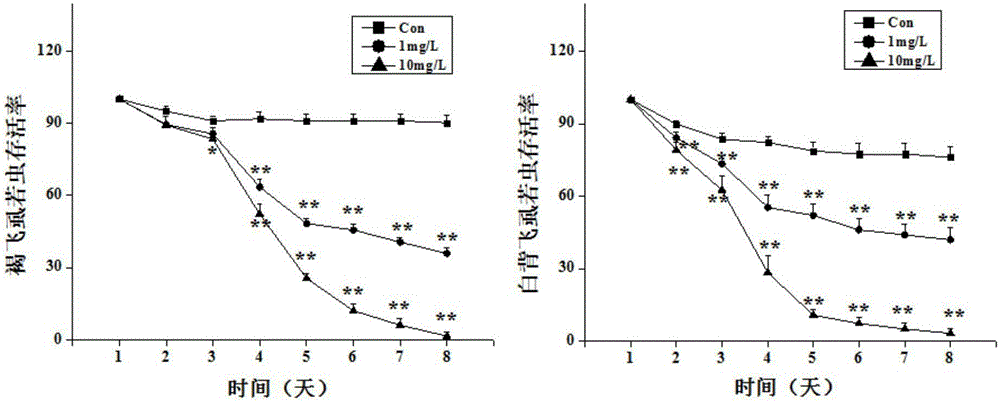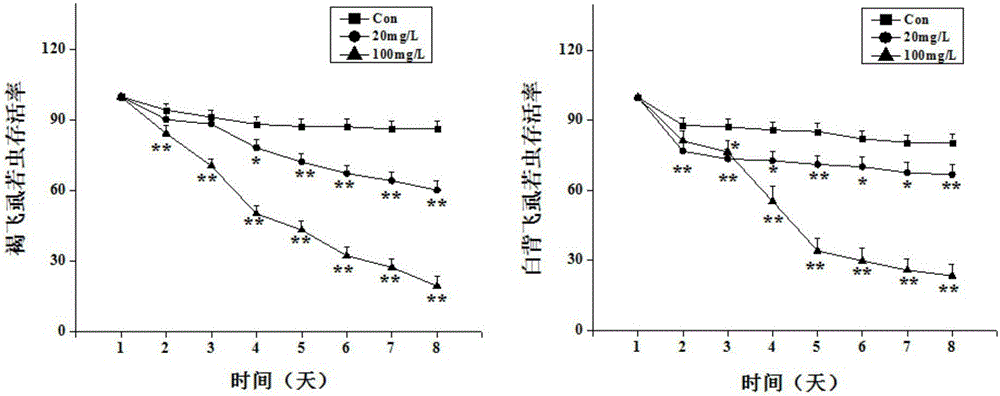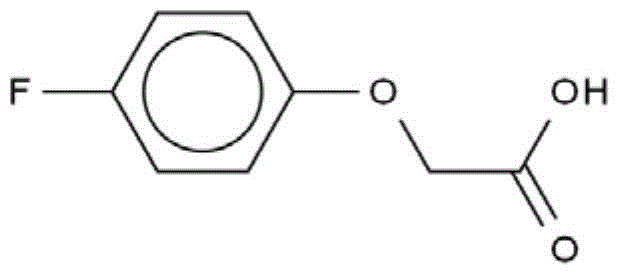Method for stimulating rice induced insect resistance
A technology of insect resistance and rice, applied in botany equipment and methods, chemicals for biological control, animal repellent, etc., can solve the problems of no application in production, achieve effective pest control, high pest control The effect of economic benefits
- Summary
- Abstract
- Description
- Claims
- Application Information
AI Technical Summary
Problems solved by technology
Method used
Image
Examples
Embodiment 1
[0019] Example 1: The root absorption of p-fluorophenoxyacetic acid to treat rice reduces the survival rate of rice planthopper nymphs
[0020] In this example, the concentrations of p-fluorophenoxyacetic acid used are 1 mg / L and 10 mg / L. The rice used is nutrient solution cultured rice, planted on a single plant; the treatment method is to add p-fluorophenoxyacetic acid to the rice nutrient solution to a final concentration of 1mg / L or 10mg / L, and use the nutrient solution without adding p-fluorophenoxyacetic acid as control. After 12 hours of p-fluorophenoxyacetic acid treatment, put a special glass cover (diameter 4cm, height 8cm, and 48 small holes with a diameter of 0.8mm evenly distributed on the wall of the tube) on each rice stalk, and insert the newly hatched brown planthopper or There were 15 white-backed planthopper nymphs, and the top of the glass cover was sealed with a round sponge. The experiment was carried out in an artificial climate room with a temperature...
Embodiment 2
[0021] Embodiment 2: p-Fluorophenoxyacetic acid stem and leaf spray treatment improves the resistance of rice to rice planthopper nymphs
[0022] In this example, the concentrations of p-fluorophenoxyacetic acid used are 20 mg / L and 100 mg / L. The rice used is nutrient solution cultured rice, planted on a single plant; the treatment method is to prepare p-fluorophenoxyacetic acid with water to a corresponding concentration (20mg / L or 100mg / L), and then use a small sprayer to spray the rice stems and leaves; as comparison. After the fog droplets on the rice stems and leaves are completely dried up, put a special glass cover (4cm in diameter, 8cm in height, 48 small holes with a diameter of 0.8mm evenly distributed on the wall of the tube) on the rice stems, and insert the newly hatched brown planthopper or white back There were 15 planthopper nymphs, and the top of the glass cover was sealed with a round sponge. The experiment was carried out in an artificial climate room with...
Embodiment 3
[0023] Example 3: p-Fluorophenoxyacetic acid itself has no effect on the survival of rice planthopper
[0024]In order to exclude the possible influence of p-fluorophenoxyacetic acid itself on the survival rate of rice planthopper nymphs, in this example, the gastric poisoning and contact killing effects of different concentrations of p-fluorophenoxyacetic acid itself on rice planthopper nymphs were measured. In the experiment of determining the gastric toxicity of p-fluorophenoxyacetic acid on rice planthopper nymphs, p-fluorophenoxyacetic acid with a concentration of 5, 20, and 50 mg / L was selected to be added to the artificial diet of planthoppers. Artificial feed with phenoxyacetic acid. Artificial feed containing different concentrations of p-fluorophenoxyacetic acid (20 μL at each end) wrapped with Parafilm sealing film was placed at both ends of a glass double-way tube with a diameter of 4 cm and a height of 8 cm, and 15 newly hatched white-backed fly were added to the ...
PUM
 Login to View More
Login to View More Abstract
Description
Claims
Application Information
 Login to View More
Login to View More - R&D
- Intellectual Property
- Life Sciences
- Materials
- Tech Scout
- Unparalleled Data Quality
- Higher Quality Content
- 60% Fewer Hallucinations
Browse by: Latest US Patents, China's latest patents, Technical Efficacy Thesaurus, Application Domain, Technology Topic, Popular Technical Reports.
© 2025 PatSnap. All rights reserved.Legal|Privacy policy|Modern Slavery Act Transparency Statement|Sitemap|About US| Contact US: help@patsnap.com



